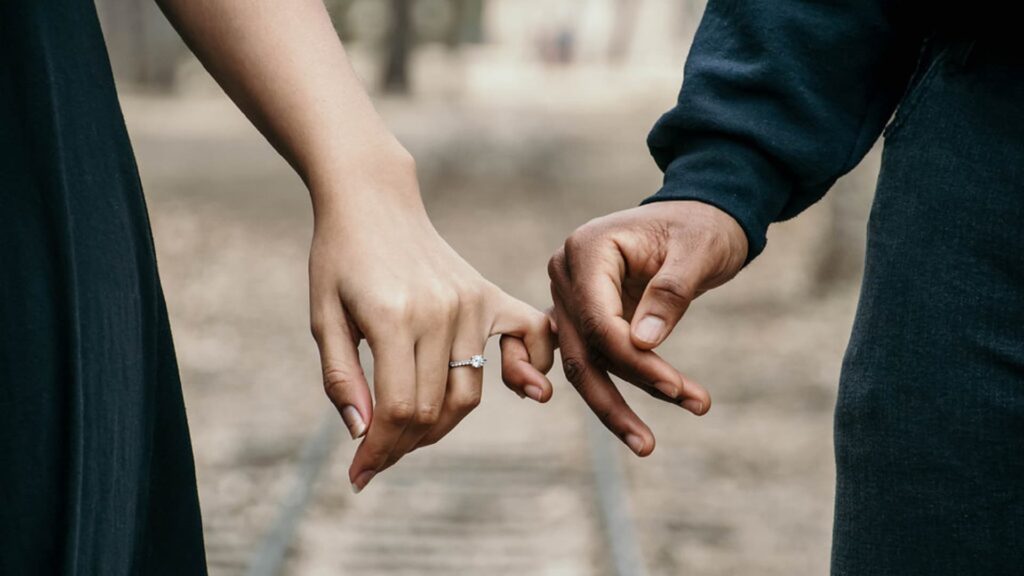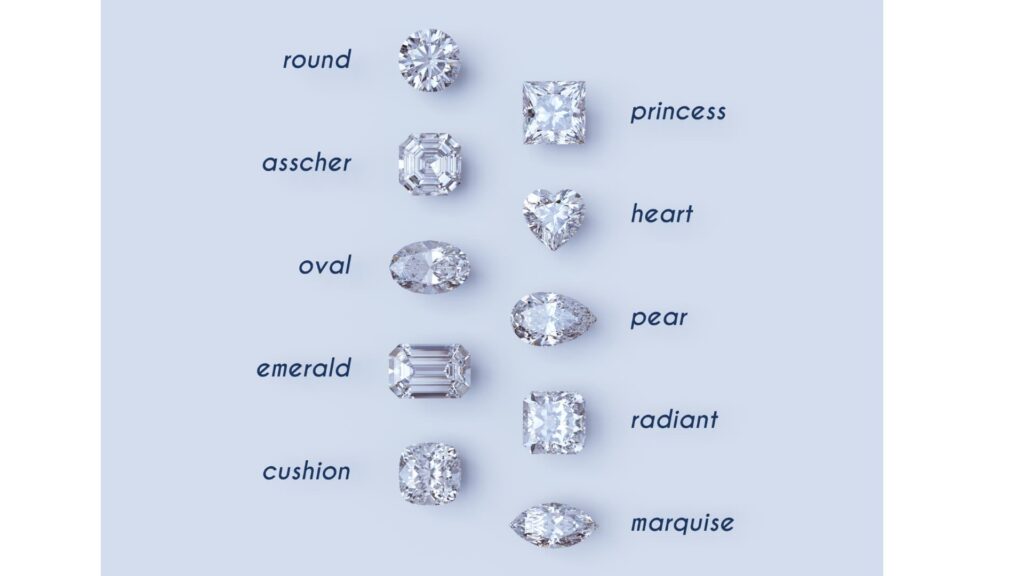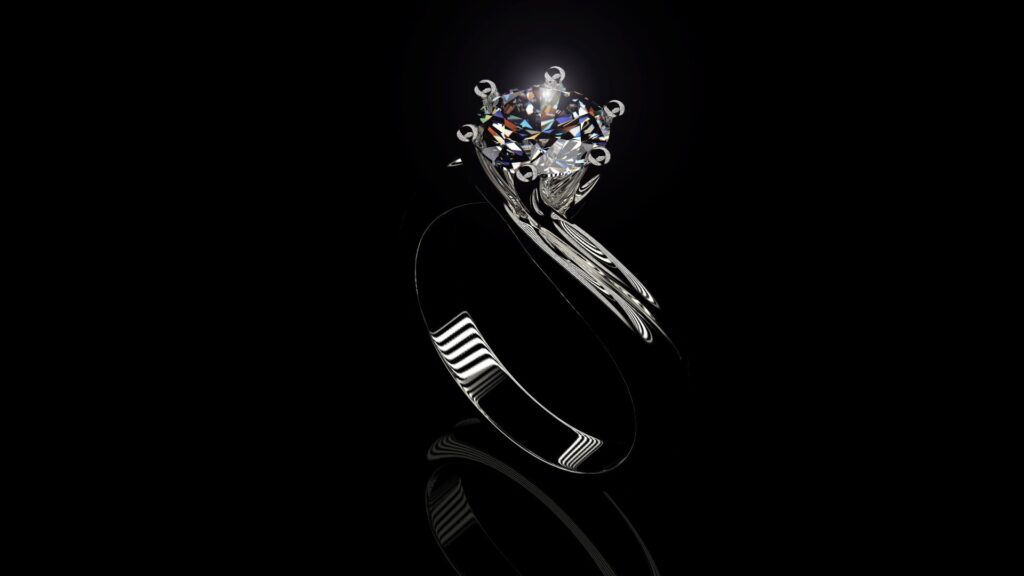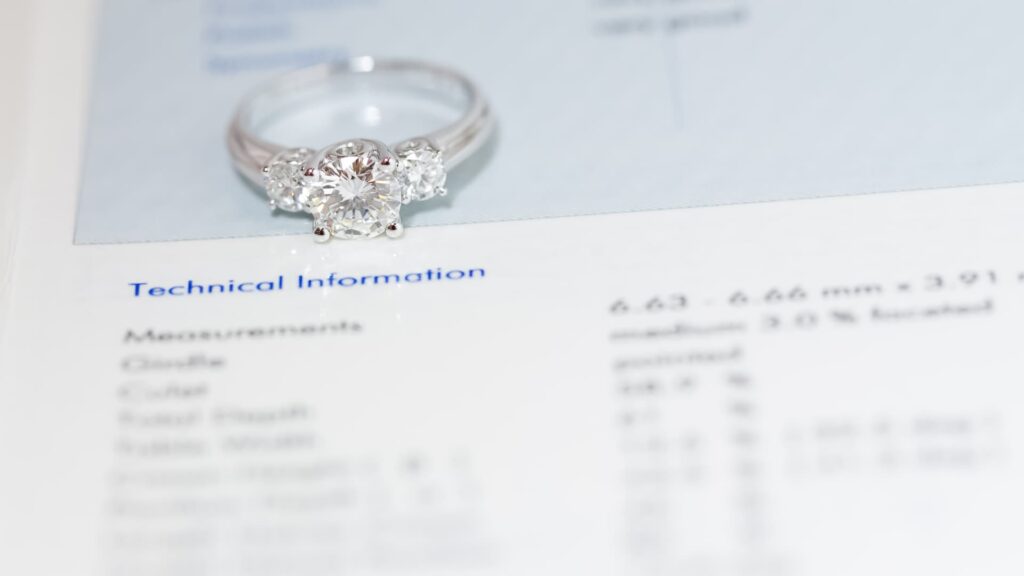Choosing a diamond ring for your engagement can be quite exciting. Diamonds are described based on four Cs: color, carat weight, cut quality, and clarity. You can compromise on the color and clarity, but never on cut quality. And carat is, of course, a matter of budget.
For instance, choosing either VS1 or VS2 will not make a big difference because the impurities are not noticeable to the naked eye. Similarly, when regarding color or clarity, mediocre grades will not affect the radiance of the diamond.
But choosing a poor-cut diamond will not sparkle or dazzle on your finger. To get the best sparkle or “fire,” we recommend getting a round-cut, or the next best option, a princess-cut diamond. But if you don’t like these shapes and prefer a heart shape or a cushion-cut, it is completely your choice!
Let’s discuss the best diamond cut for an engagement ring.

What is Diamond Cut?
In popular parlance, the diamond’s cut is the shape (round, princess, cushion-cut, etc.) in which the diamond is cut and appears on the ring.
This is the more common way in which a diamond’s cut is perceived. For the purpose of clarity, we will be using the term “diamond shape” to signify this.
Technically, “cut” represents one of the four Cs of a diamond’s quality rating. It refers to how well the precious stone is cut and polished and how proportional its depth and width are.
This is graded by gemological institutes and is assessed by professionals to determine the diamond’s worth. We will discuss this later in the article.
Related article: What Is a Certified Diamond: Certificates Explained
What Diamond Shape Should I Look For in My Engagement Ring?
Let’s try to break this question down into the factors that come into play when you wear a diamond ring.
Brilliance or Fire
Diamonds are loved all over the world for their radiance and the way they seem to emit their own light. This light is the result of rays of light getting trapped from the sides of the ring and becoming concentrated on becoming a single beam, which is known as Diamond Fire.
From a pure “Fire” perspective, there is no comparison to the round cut shape.
Personal Choice
Buying a diamond engagement ring is something extremely personal, so rather than thinking about what looks best to you, perhaps you should consider what shape your partner would love to wear. Do they have a special connection to the heart shape? Are they a perfectionist who loves squares and rectangles because of their symmetry?
Formality and Respect for the Occasion
An engagement is a gathering of families, not just a celebration of two individuals. Therefore, engagement rings have to bear the weight of history and the scrutiny of the world.
On such occasions, even the most individualistic of people tend to go a little traditional, so perhaps pear shapes and other oddities might not suit the bill.
Finger Shape
If you have been observant of your partners’ hands, you might have noticed the shape of their fingers. Certain shapes go well with certain types of fingers, so that is something you should keep in mind.
For instance, if your partner has dainty hands, then it may be best to choose a simpler diamond like a round cut. If they have short fingers, you may want to select a longer shape diamond to make their finger look longer.
Now let’s discuss the various diamond shapes that you can look at for your diamond engagement ring.

Diamond Shapes and Tips for Buying Them
1. Round Cut Diamond
The round cut is the most popular and most expensive cut compared to other diamond shapes. There are a number of reasons for this.
Creating a perfectly round diamond requires a lot of time and effort. Almost 60 percent of the rough diamonds are lost during the round cut process. A cutter cannot reuse the diamonds lost during the cutting process, which is why a round cut is generally more expensive compared to other diamond shapes.
Schematically a round brilliant cut diamond has almost 58 facets: 33 on the crown and 25 on the pavilion. These facets help in accumulating even the tiniest rays of light around it, centering them and giving a brilliant white light at the top.
Round-shaped diamonds do not have a large surface area, but their sparkle can make the diamond appear bigger on your finger.
Tips for Buying a Round Cut Diamond Ring
If you intend to buy a round-cut diamond, don’t forget to check the presence of 8 hearts when looking down through the pavilion and eight arrows while viewing the diamond from the table-up position.
For example, James Allen has a spectacular True Heart Diamond collection where these hearts and arrows are visible.
If everything is fine and the total price of the round-shaped diamond is 20 to 40 percent higher than other diamond shapes, then you may consider buying the diamond ring.
Additionally, if the carat size or weight of the diamond does not matter to you, you may select a ring based on its weight. A 0.9-carat diamond ring will be cheaper than a 1-carat diamond ring, while the stone will probably appear to be of similar size.
A round-cut diamond has brilliance and sparkles more compared to other diamond shapes. This lets you compromise a bit on clarity and color. You can choose SI1or SI2 clarity and I or J color grade while choosing a round shape diamond ring for your engagement.
Related article: I vs J Color Diamonds Compared
2. Princess-Cut
The princess cut is a square-shaped stone with a pyramidal shape when looked at from the side. It is quite popular among diamond ring buyers because it is priced lower when compared to round-shaped diamonds.
You don’t need a single large stone to make a princess cut. Removing one-fifth of the rough stone is enough to make this cut. Moreover, it has almost identical brilliance and fire as that of round cut diamonds.
The princess cut shape looks even bigger compared to a round-shaped diamond. Their face-up size is a bit smaller but has a longer diagonal measurement that makes them appear larger. The square cut is perfect for wearing on engagements or special occasions.
There are some limitations if you purchase a princess-cut diamond ring. The sharp corners on the princess cut are susceptible to chipping and cracking. The corners should be protected by prongs of the ring. Moreover, make sure there are no inclusions or impurities on the edges of your princess cut diamond.
Tips for Buying a Princess Cut Diamond Ring
If you intend to purchase a princess cut diamond, consider buying SI1 clarity grade. Additionally, if you want a white-colored diamond ring, then you can choose H or I color grade. Some people like to wear yellow or rose gold-colored rings. These individuals may like to select a J color grade princess cut diamond ring.
Related article: I vs J Color Diamonds Compared
3. Cushion-Cut Diamond
Cushion-cut diamonds are rectangular or square-shaped with round edges. The shape of the cushion cut appears larger compared to round-cut diamonds.
Moreover, cushion cut diamonds are 25 to 45 percent cheaper than the round cut. You may like the cushion-cut for its elegance and fire. These cuts have one limitation. Their face-up size is a bit small compared to other diamond shapes.
Tips for Buying a Cushion Cut Diamond Ring
If you decide to purchase a cushion-cut diamond ring for your engagement, stick to the H color grade. Additionally, the cushion cut hides impurities or inclusions well. Therefore, you may want to consider SI1 or SI2 clarity cushion cut diamonds for your engagement. The diamond ring will look flawless with these clarity grades.
4. Emerald-Cut Diamonds
If you are searching for a diamond cut that is distinguished and sophisticated, then choose an emerald-cut diamond. These diamonds are 12-42 percent cheaper than the round cut diamonds. They have an elongated shape. So it will give a slimming effect on your finger.
If you have wide and shorthands, purchase an emerald-cut diamond ring for your engagement.
The significant facets on the diamond give a box of mirror effect when you view inside the diamond. However, there are some limitations to these cuts. They lack brilliance, and you can detect impurities very well in this shape. Moreover, their face-up size is 5 percent smaller than round-cut diamonds.
Tips for Buying Emerald Cut Diamonds
Try to stick to VS2 clarity and H color grade while buying emerald-cut diamonds. You can opt for a shallow stone as its face-up area is larger.
Related article: VS1 vs. VVS2 Diamond Compared
5. Pear-Cut Diamonds
Pear-cut diamonds are quite attractive and unique. Their face-up area is 8 percent larger than round-cut diamonds while being 10 to 30 percent cheaper than round-shaped diamonds.
Pear-cut diamonds are a perfect mix of round- and marquise-cut diamonds. The shape looks like a teardrop with one side pointed and the other side rounded. They may make your hand look slimmer and more graceful.
However, there are some downsides. The tip portion of the pear shape diamond may be subject to snag. So, it should be well protected by prongs. Additionally, you should check the lab report to ensure that the pearl-cut diamond ring has no impurities or inclusions at the tip. Again, it isn’t easy to find a pear-shaped diamond with fewer bowties.
Tips for Buying Pear Cut Diamonds
You can opt for an H color-grade pear-shaped diamond with SI1 or SI2 clarity.
Related article: VS1 vs. VVS2 Diamond Compared
6. Marquise-Cut Diamonds
The marquise cut makes a diamond look bigger. Your hand will also look slimmer after wearing this diamond cut.
Marquise-cut diamonds have the largest face-up area compared to other diamond shapes. They cost nearly 25 percent less than round cut diamonds of the same carat weight.
However, there are some downsides.
Prongs should protect the tapered portion of marquise cuts to avoid chipping. Again, make sure that the pointed tips which are vulnerable should be free from impurities. It may be difficult for you to find perfectly-symmetrical marquise cut diamonds.
The marquise cuts exhibit a bowtie (dark band on the center of the stone).
Tips for Buying Marquise Cut Diamonds
Marquise-cut diamonds can hide impurities very well. So you can go for an SI1 or SI2 clarity marquise-cut diamond.
Try to purchase a marquise cut diamond ring with a minimum bow tie and H color grade. An H color marquise-cut diamond will appear white and is less expensive than high color grades. Well, you may also choose the I or J color grade in yellow or rose gold ring.
7. Asscher-Cut Diamonds
You will rarely find Asscher-cut diamonds in the market today. These diamonds have an octagonal outline, and their four corners are cropped. Their cost is nearly 19-43 percent less than round-cut diamonds.
However, Asscher-cut diamonds have some limitations. Their face-up area is the smallest compared to all fancy cut diamonds. It even cannot hide impurities like a round brilliant cut diamond.
Tips for Buying Asscher Cut Diamonds
Try to purchase an Asscher-cut diamond with VS2 clarity and H color grade. You can opt for shallow diamonds because they will appear to have a large surface area on your hand.
8. Heart-Cut Diamonds
Heart-cut diamonds symbolize love and romance. They will cost 15 to 26 percent less than round-cut diamonds.
However, they have some downsides. Their face-up area is 7 percent smaller compared to round-cut diamonds. Additionally, the tip of this diamond is prone to chipping, so it should be well protected by prongs.
It will be challenging to evaluate the small shape of heart-cut diamonds. So we suggest you always buy heart-cut diamonds above 1 carat.
Tips for Buying Heart Cut Diamonds
Try to go for a heart-cut diamond of SI1 or SI2 clarity grade and H color grade.
9. Radiant-Cut Diamonds
The radiant cut diamonds consist of 70 facets and have a lot of fire and brilliance. It has convenient edges which are comfortable to put on your finger and are durable compared to princess cut diamonds.
The radiant cut diamonds will cost you 20-39 percent less than round cut brilliant diamonds. But they have a small face-up size; that is, 4 percent smaller than round cut diamonds.
Tips for Buying Radiant Cut Diamonds
Radiant-cut diamonds can hide impurities very well. So opt for SI1 or SI2 clarity with H color grade if purchasing these diamonds.
10. Trillion-Cut Diamonds
Trillion-cut diamonds have excellent sparkle, which gives them a bold look. If you prefer its shallow cut, the face-up will appear 12 percent larger than round-cut diamonds.
However, it has some limitations. It has a unique geometry. So, you may rarely find them in the market. Their corners can be prone to chipping as well, so they should be well protected.
Tips for Buying Trillion Cut Diamonds
You should purchase SI clarity and H color grade while purchasing trillion cut diamonds.
What Is the Best Diamond Cut for My Engagement Ring?
As discussed above, there are various diamond cuts available in the market. If you choose round-cut diamonds, they will provide you with the most brilliance and sparkle, but they are expensive.
If you choose fancy cut diamonds like heart shape or pear shape for your engagement, they may not provide as much sparkle and brilliance compared to the round-cut. But they are likely to be relatively cheaper compared to round-cut diamonds.
So, the best cut for our engagement ring is purely a personal choice. It will depend on the aesthetic you prefer as well as how much money you want to invest in a diamond ring. You should figure out your preferences and then narrow down the options and select the perfect diamond ring for you.
If you intend to purchase fancy cut diamonds, then review them properly. You should look for a diamond that does not have large inclusions, mainly at the center of the gem.
Diamond Cut
The diamond’s cut quality directly impacts the brightness of the diamond. If a diamond is well cut, it will sparkle and reflect almost pure white light to your eyes. But a poor-cut diamond will appear dull on your finger.
The diamond cut is decided by considering factors like the shape of the rough stone, location of impurities, the popularity of shapes among consumers, and various others. The diamond crystals are usually octahedrons in their rough state.
How Cut Quality Impacts Shape
Diamonds are generally cut into round shapes because it is possible to cut two round stones from one octahedron with minimum loss in weight. But if impurities in a rough state are present in inappropriate locations or the crystals are twinned, the diamond can be put in a fancy cut (a cut other than a round shape).
Round brilliant cuts are usually considered standard for a diamond because the size and proportion are almost constant. However, people are looking at different shapes nowadays. But if I talk about fancy diamond cuts, they are not well proportioned but are still liked by many people.
For instance, heart-shaped diamonds symbolize romance, so people may choose to give heart-shaped diamonds on Valentine’s Day and wedding anniversaries.
Pear-shaped diamonds look like teardrops, so some people may choose pear shape diamonds for their earrings.
The size of the diamond also plays a significant role. A diamond with less than 0.02 carats is usually given a simplified cut, whereas large diamonds are given fancy cuts.
Grading of Diamond Cut
The American Gem society grades the diamond cut into ideal, excellent, very good, good, fair, and poor. I will suggest you buy ideal cut diamonds while purchasing your engagement ring.
Similarly, the Gemological Institute of America (GIA) grades the cut of the round diamond from excellent to poor. The GIA cut grades are as below.
1. Excellent Cut Diamond
Excellent cut diamonds provide an elevated level of fire and brilliance. Here, almost all the incoming light reflects through the table, so it radiates with sparkle.
2. Very Good Cut Diamond
A very good cut diamond provides extraordinary brilliance and fire. Here the majority of the incoming light will reflect through the table. It gives almost the same sparkle like that of an excellent cut diamond to the naked eye.
3. Good Cut Diamond
A good cut diamond represents sparkle and brilliance. Here most of the light reflects through the table into your eyes. These diamonds are not too expensive.
4. Fair Cut Diamond
Fair cut diamonds will represent a slightly lower brilliance compared to good cut diamonds. Most of the light falling in these diamonds exits from the sides and bottom. These diamonds can be a satisfactory choice for lower carat rings.
5. Poor Cut Diamond
Poor-cut diamonds have almost no sparkle or brilliance. Almost all the light entering the diamond escapes from the sides and bottom.
Final Thoughts
Diamonds are precious stones. You spend thousands of dollars while purchasing a diamond ring for your loved one. You should never compromise on the cut quality of the diamond; otherwise, your diamond will not have the sparkle and shine that you want to reflect in their eyes.
Always ensure that you receive a diamond certificate from a reputed gemological laboratory while purchasing a diamond ring.
Related articles:
What Is a Certified Diamond: Certificates Explained
James Allen Yellow Diamonds
Everything About Baguette Diamonds
How Can You Tell Someone’s Ring Size?






